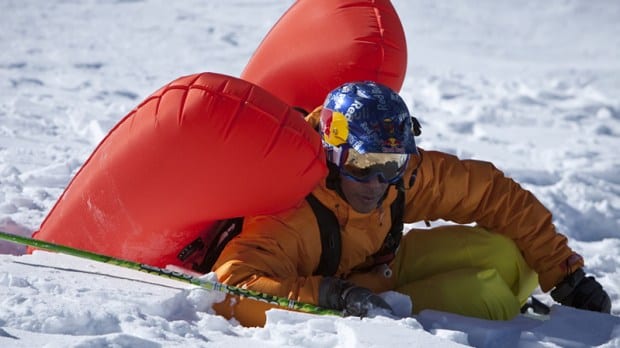Does that avalanche airbag really help?
Since it’s winter, we are going to keep talking about avalanches. Since indications for resuscitation have been discussed before, now we will turn towards prevention. Two main ideas, first, avoid triggering an avalanche, and second, if you find yourself caught in one, try not to get buried. It makes sense, as the data from older studies is pretty clear that people who are buried die at a markedly higher rate than those who are not (52% vs 4%). What’s more, for those that are buried, the quicker they are found decreases their mortality, thus people buried less deep would likely have a higher survival rate.
Enter airbags, which were invented to prevent this “critical burial” that causes increased mortality (critical meaning impairment of airways). They do this by basically making you much larger and more buoyant by inflating a large balloon that is strapped to your back. At least, that’s the theory.
There wasn’t a lot of strong research devoted to them before implementation, and as they weren’t created by Roche, post-marketing research was lacking as well. Tie observer bias into this (people weren’t reporting near misses that didn’t involve airbags) and you are left with almost nothing of value to base recommendations on.
These authors wanted to fix that, so they did this study to determine the effectiveness of airbags based on preventing critical burial and mortality, as well as documenting frequency and causes of deployment failures. To do this, they looked at prior avalanche accident records from multiple countries, culling only worthwhile data that would show a difference between airbag users and nonusers. Thus, single victim events, small avalanches, or victims who weren’t seriously involved were removed in an attempt to reduce bias.
And once they crunched the numbers, they found out that airbags really do help. If you combine airbag failures with airbag inflations, the absolute risk reduction for critical burial is 29% (56%-27%), and the absolute mortality reduction is 17% (34%-17%). If you combine airbag failures with those not wearing airbags to begin with (why?), then risk reductions for critical burial and mortality are 35% and 23%, respectively. When you combine these values to adjusted mortality, you get a risk reduction of 11%, or a NNT of 9 for mortality with airbag use. Not too shabby.
Deployment failures occurred an alarming 20% of the time. Of these failures, 72% were attributed to operator error (not deploying them appropriately or incorrect maintenance). Slightly concerning, 12% of the failures involved destruction of the airbag during the avalanche. Of course, the absolute failure rate due to destruction or device failure is right at 5%.
So yes, if you’re going anywhere that there’s a risk of avalanches, you should wear an airbag. Also you should carry a beacon. And, like most other life saving measures, be they medical or technical, you’re only as good as what you do. Thus, read the instructions and know how to use it before you go out-of-bounds. However, this study did have a higher mortality of airbag users from prior studies (11% vs 3%), so don’t expect an airbag to make you immortal. Certainly, don’t do stupid things simply because you think you have a safety net (although it’s been shown that this doesn’t really occur). Of note, the usual problems with poor data due to non-standardized reporting as well as a low total number of victims apply to interpretation of this data.
Haegeli P, Falk M, Procter E, Zweifel B, Jarry F, Logan S, Kronholm K, Biskupič M, Brugger H. The effectiveness of avalanche airbags. Resuscitation. 2014 Sep;85(9):1197-203. [PMID 24909367]
Further Reading
- Hensley J. Predicting survival after avalanches. EBM Gone Wild
- Hensley J. Do air pockets help avalanche survival? EBM Gone Wild
- Hensley J. Wear the helmet anyway. EBM Gone Wild
- Hensley J. Do ski helmets cause risk compensation?. EBM Gone Wild
- Hensley J. Treating serious frostbite. EBM Gone Wild

EBM Gone Wild
Wilderness Medicine
Emergency physician with interests in wilderness and prehospital medicine. Medical Director of the Texas State Aquarium, Padre Island National Seashore, Robstown EMS, and Code 3 ER | EBM gone Wild | @EBMGoneWild |

